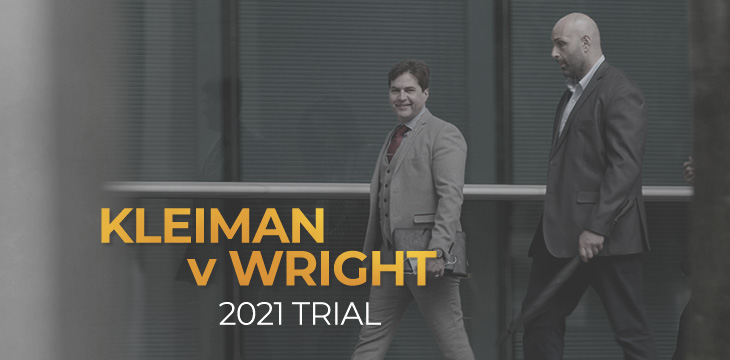To many, the idea that Satoshi Nakamoto, pseudonymous inventor of Bitcoin and undoubted multi-billionaire (to put it conservatively) wouldn’t want to stick around and take credit for his innovation is a strange one. The invention is so widely celebrated that Satoshi is and always will be the head of the digital asset pantheon; their popularity is such that people continue to send tips to addresses thought to have been owned by the creator, and the white paper describing Bitcoin has become a hallowed artefact to anyone with more than a passing interest in the subject.
In 2015, Gizmodo and Wired published reports stating that Dr. Craig Wright, an Australian computer scientist and polymath was the most likely candidate to be Satoshi. The revelation had come from an as-yet unidentified leaker who had passed on documents pointing to Dr. Wright as the man behind the Satoshi Nakamoto name.
After years of speculation, the secret was out.
A few short years later, and Dr. Wright is sitting in a courtroom with an unhappy lawyer pointing him out to a jury, all of whom have eyes on the man they know to be Satoshi Nakamoto.
“This man robbed his dead best friend.”
Satoshi in the crosshairs
For all the rapturous praise due to Satoshi Nakamoto, the person who invented Bitcoin has an enormous target on their back. In fact, they probably have many.
Not so long ago, Bitcoin was more or less only associated with things like Silk Road and the purchasing of drugs and much darker activities, so much so that for a time that was Satoshi’s legacy. In his absence, it appeared that Satoshi had invented a modern money laundering machine (as it turns out, Bitcoin and the blockchain are far from the ideal vehicle for crime).
To be associated with such a tool had already proven to be dangerous. Liberty Reserve, a digital currency service quite distinct from Bitcoin, was shut down by the U.S. government in 2013 and seven of its key personnel were charged with money laundering and operating an unlicensed financial transaction company. Over $6 billion in criminal funds were found to have been laundered through Liberty Reserve: the founder, Arthur Budovsky, was sentenced to 20 years in prison.
From the perspective of Dr. Craig Wright, who has always maintained that his system of electronic cash as described in the white paper is intended to work within and even further the aims of the law, seeing Bitcoin become associated with drug trafficking while the U.S. government aggressively pursues those who created systems used in criminal activity would have been a grotesque sight. Dr. Wright has described himself as ‘embittered’ while he was away from the spotlight and watching his creation be used to power drug marketplaces like Silk Road—and worse—the irony being that the Bitcoin he had described was the antidote to such criminality.
“Silk Road was poison to me,” Dr. Wright wrote in a blog post in 2019.
“I saw a decade of work corrupted, twisted, and for a time I despaired. Bitcoin was like a child to me. I saw a child who had lost their way and become the worst thing they could be. One who was into all that was wrong, twisted, and corrupt.”
Beyond all that, Satoshi Nakamoto should be inconceivably rich. To out Satoshi Nakamoto is to personally identify one of the richest people on the planet, and not in a vague assets-hidden-offshore way. The blockchain being as public as it is, even a conservative reading of its earliest blocks shows an enormous wealth of unmoved Bitcoin that must belong to Satoshi Nakamoto. That kind of visible wealth is a dangerous thing.
When news first broke that Dr. Wright is Satoshi Nakamoto, the Australian did not seem to be thinking of the praise and the fame. Quite the contrary, Dr. Wright was worried about the targets. And he was right.
The reveal
The Wired and Gizmodo leaks kicked off a media circus that hasn’t truly ended to this day. Journalists turned up on his doorstep, his house and office was raided by the Australian Tax Office, and it wasn’t long before the inevitable contras come out of the woodwork to denigrate Dr. Wright and try to prove to themselves that the fabled Satoshi Nakamoto could not be a computer scientist quietly living in Australia.
Dr. Wright did not embrace the fame. He did the opposite. When he did appear, it was to make clear that he has no interest in demonstrating to anyone that he is the inventor of Bitcoin and that all he wants is to be left alone. He told the BBC in 2016:
“If I released a paper that benefits people, why do I have to take credit for it?”
“I don’t work and invent and write papers and code by coming in front of TVs. I don’t want money. I don’t want fame, I don’t want adoration, I just want to be left alone.”
Around this time, Dr. Wright sounded agitated. Who could blame him? The same day Wired and Gizmodo published their stories was the same day his house was raided by the Australian Government. Dr. Wright would eventually be forced to embark on a series of costly defamation actions as a result of the harassment he would face online (he has so far emerged victorious).
Already wracked with worry over the things his invention had been used for in his absence, what good could possibly come from more media attention?
Enter the Kleimans
But amid all of this reluctance, beginning years before Wired or Gizmodo had ever heard of him, Dr. Wright was communicating openly with one person about this giant secret. He was emailing Ira Kleiman, the brother of Dave Kleiman, his recently deceased best friend with whom Dr. Wright had worked in a variety of contexts.
The death of Dave had clearly impacted Dr. Wright. He posted an emotional tribute video to Dave on YouTube in 2013, shortly after his passing. In it, he said:
“Dave made the world a better place. He made my world a better place. I’m proud to say Dave was my friend. I’m proud to say I knew Dave. And I say, I’ll miss you, Dave.”
From emails submitted in Kleiman v Wright, it seems plausible that Dave helped Dr. Wright edit the white paper, and it is in this spirit that Dr. Wright appears to have reached out to the Kleiman family in 2014, months after Dave’s death. In 2014, he wrote to Lou Kleiman, Dave’s father:
“Please understand, I do not seek anything other than to give you information about your son. Know also that Dave was a key part of an invention that will revolutionize the world.”
Dr. Wright was passed off to Ira Kleiman, which kicked off a years-long back and forth between the two which mostly consisted of Dr. Wright providing what information he could about Dave, including helping them find any assets that Dave might have had at the time he died. It was Dr. Wright who first alerted Ira to the fact that Dave, being a cybersecurity afficionado, likely had encrypted storage devices in his home and that the Kleiman family should do everything possible to preserve them.
Dr. Wright was light on specifics about the extent of Dave’s contribution to Bitcoin, but he would often talk about Dave’s skills in written communication. He told Ira over email that Dave would help Dr. Wright make his language more ‘serene.’ Sometimes he would talk-up Dave’s involvement, apparently eager to offer comfort to the family of a man that he clearly had a lot of respect for, but there were no specifics. Despite there being exhibits of comprehensive e-mail exchanges between Dave and Dr. Wright over collaborations in the past, there is none of this regarding the invention of Bitcoin or the writing of the white paper. But from Dr. Wright’s actions and the emails that do exist, it is highly plausible that Dave helped Dr. Wright communicate the ideas that ended up in the now-famous paper.
The key point is that Dr. Wright, then totally anonymous with regard to his status as Satoshi Nakamoto, was making himself vulnerable in order to give his best friend the credit that was coming to him. Given how reluctant we now know Dr. Wright to have been about being outed, this seems like an extraordinarily good-natured step to take—but one that makes all too much sense once you’ve seen the aforementioned tribute video.
But as we saw from the expert medical report produced in the Kleiman suit, Dr. Wright’s autism can often make him too trusting and finds it difficult to assess the true motivations of others. Unfortunately, for Dr. Wright, this bores out in his relationship with the Kleimans.
The two were still communicating in 2017 on friendly terms. Ira asked Dr. Wright for details about his brother, and Dr. Wright gave them. But unbeknownst to Dr. Wright, Ira was already contacting lawyers as early as 2016, claiming that his brother had invented Bitcoin and that he was taking legal action against a man he said had stolen his fortune and promising that the lawyers who take his case will receive a substantial share of what is sure to be the biggest legal sum ever awarded. Kleiman wasn’t interested in his brother or his work with Dr. Wright – by this point, all his energy seems to have been poured into an eventual lawsuit that Ira hoped would give him access to half of the Satoshi fortune.
While Dr. Wright was helping shed light on his best friend, Ira Kleiman had already sold the staggering financial interest in the outcome of a lawsuit that hadn’t even been failed yet.
Who wants to be Satoshi Nakamoto?
The horse has already bolted with regard to the Satoshi Nakamoto identity. Who could know this better than Dr. Wright, who after having taken the rare step of identifying himself to the family of his dead best friend, is now the defendant in one of the biggest single lawsuits ever filed as a result?
For all his reluctance and the information he shared with the Kleimans, what did Dr. Wright get? Sued by the brother of his best friend, and dragged through an arduous four-year period of depositions, hearings and multiple media circuses to finally end up in court, while opposing counsel point to him:
“That man there robbed his dead best friend.”
Who would want to be Satoshi Nakamoto?
Dr. Wright’s testimony continues Monday. Check out all of the CoinGeek special reports on the Kleiman v Wright YouTube playlist.
New to blockchain? Check out CoinGeek’s Blockchain for Beginners section, the ultimate resource guide to learn more about blockchain technology.








